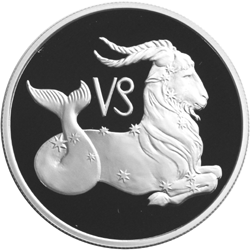Unsolved:Capricorn (astrology)
| Capricorn | |
|---|---|
| Zodiac symbol | Fish–Goat Hybrid (Sea Goat) |
| Duration (tropical, western) | December 21 – January 19 (2024, UT1)[1] |
| Constellation | Capricornus |
| Zodiac element | Earth |
| Zodiac quality | Cardinal |
| Sign ruler | Saturn, Uranus |
| Detriment | Moon |
| Exaltation | Mars |
| Fall | Jupiter |
Capricorn (♑) is the tenth astrological sign in the zodiac, originating from the constellation of Capricornus, the horned goat. It spans the 270–300th degree of the zodiac, corresponding to celestial longitude. Under the tropical zodiac, the sun transits this area from December 21 to January 21 each year,[2] and under the sidereal zodiac, the sun transits the constellation of Capricorn from approximately January 16 to February 16. In astrology, Capricorn is considered an earth sign, negative sign,[3][4] and one of the four cardinal signs. Capricorn is said to be ruled by the planet Saturn. In Vedic Astrology Capricorn was associated with the Crocodile but modern astrologers consider Capricorn as Sea goat. Its symbol is based on the Sumerians' primordial god of wisdom and waters, Enki,[5] with the head and upper body of a goat and the lower body and tail of a fish.[6] Later known as Ea in Akkadian and Babylonian mythology, Enki was the god of intelligence (gestú, literally "ear"), creation, crafts; magic; water, seawater and lakewater (a, aba, ab).[7]
Cultural significance
In India, zodiac sign of Capricorn is celebrated as the Makara Sankranti festival.[8] The Indian astronomical calendar is not based on the Western Gregorian or Julian date keeping system and has a differential lag. Hence, the festival is celebrated on either of 14 or 15 January every year, when, as per the Indian astronomical calendar, the Sun enters the Capricorn sign.
References
Citations
- ↑ Astronomical Applications Department 2011.
- ↑ Oxford n.d., sv. Capricorn and Aquarius.
- ↑ Mayo 1979, pp. 38–41.
- ↑ Ciubotaru 2008.
- ↑ Enki n.d.
- ↑ Adams 2014
- ↑ Augustin n.d.
- ↑ Makar sankranti festival 2016.
Sources
- Astronomical Applications Department (2011), Multiyear Computer Interactive Almanac, 2.2.2., Washington DC: US Naval Observatory Longitude of Sun, apparent geocentric ecliptic of date, interpolated to find time of crossing 0°, 30°.... The year stated applies to the December date; the year for the January date is one year greater.
- Adams, Leeuba Leshia (2014). "Astrology Vocation". http://astrochrysalis.com/astrology-vocation-html/.
- Augustin, M. (n.d.). "Capricorn Mythology, what is it about?". http://www.serendipity-astrolovers.com/Capricorn-Mythology.html#axzz3aFrz74m4.
- Ciubotaru, Dan (February 1, 2008). "Capricorn, Scorpio, Leo: In search of power". http://www.ciuboda.com/post/power-zodiacal-signs-leo-scorpio-capricorn/100.
- "Enki". n.d.. http://one-evil.org/content/entities_gods_enki.html.
- "Makar sankranti festival". http://www.rudraksha-ratna.com/makarsankranti.html.
- Mayo, Jeff (1979). Teach Yourself Astrology. London: Hodder and Stoughton.
- "English Dictionary, Thesaurus". Oxford Dictionaries. n.d.. https://en.oxforddictionaries.com/. Retrieved June 7, 2018.
External links



